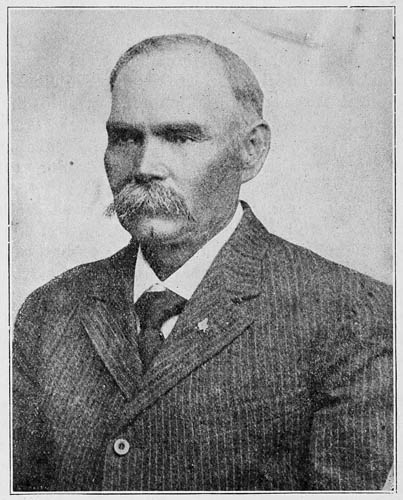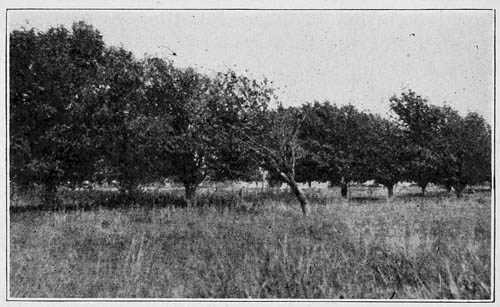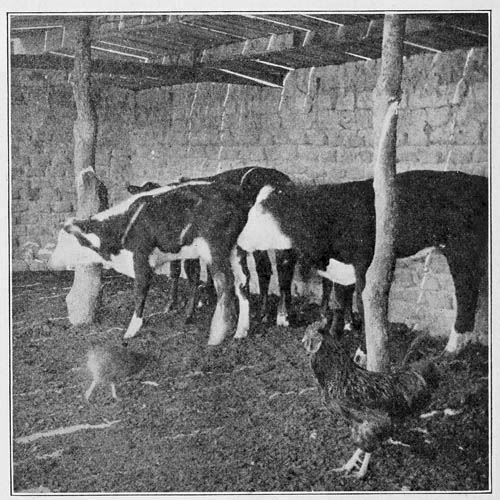Returning to civilian life in 1883, I struck north from Fort Elliott and went over on the Canadian River, in what is now Hutchinson county, Texas, and hired to a big cow outfit that became widely known as the Turkey Track Ranch, owned by a Scotch syndicate, and then managed by C. B. Willingham. That same year I filed on two sections of land on Bent Creek, taking in the site of the original Adobe Walls ruins.
I built my house right at the west edge of the old sod building which by that time stock had rubbed to the ground. In the front yard, however, when the south wind swept the dirt clear, could still be seen the foundations of the old ruins. Whoever built those walls certainly built them well.
When I homesteaded my two sections of school land and built my house at Adobe Walls, I expected to live there the balance of my days, contented and happy. Everything was to my liking--pure air, good water, fruitful soil, game, and room enough for a man to turn round without stepping on some fellows toes. It was the land of my boyhood dreams, and I was satisfied.

I improved my ranch in many ways. I diverted the course of Bent Creek until its clear, swift waters flowed almost at my doorstep, and was able to undertake extensive irrigation. I planted an orchard of 200 carefully selected trees, consisting of apples, peaches, pears, plums, apricots and cherries, together with a small vineyard. I am confident that this was the first orchard ever planted in Hutchinson county, perhaps in the northern Panhandle. It was well irrigated, and the orchard thrived astonishingly. There was not a better orchard in the southwest, and some of the trees are still standing. In my yard I set out a number of cottonwoods which grew rapidly and became big, strong trees, affording generous shade in hot summer. I am sure that my thirty acres of alfalfa was the first ever seen in that section. For many years it produced an unfailing and profitable crop.
In those days our nearest postoffice was Zulu, on Palo Duro, twenty-five or thirty miles distant. One day L. B. Miller, then district attorney, now practicing law at Allenreed, Texas, was at the Turkey Track Ranch. He heard about the way we had to go for mail, and said that he would have a postoffice established at the ranch and make me postmaster. I received my commission and was postmaster at Adobe Walls for nearly twenty years, first at the ranch and later at my home. When I moved down to my own place I opened a little store, carrying in stock such simple things as would supply cowboy trade. It may cause a smile when I say that my two most important articles of merchandise were candy and chewing gum. No schoolgirl could be as foolish as a cowboy about candy and chewing gum. The boys seemed to crave such things, and bought more candy and chewing gum than they did tobacco.
The little log house, to be seen in an accompanying illustration, stands on the ruins of the first Adobe Walls. I built the house in 1883, shortly after I filed on my claim. It is fourteen feet square, and stands a mile south of where the fight took place.
The illustration showing the bluff on the east side of Adobe Walls Creek is a excellent view of the landscape. In coming to attack Adobe Walls in the early morning, the Indians rode up the valley from the right, and were first discovered near the grove of trees.
Mine was a happy life in my cabin at Adobe Walls, without fret or worry, and with abundance of everything for my simple needs. During a greater part of the year wild ducks and geese frequented the Canadian and its tributaries, literally by thousands, and deer and turkey were commonly found along the creeks.
The meat of the buffalo, in my opinion, had a much better taste than beef, and was more easily digested. I was always a big meat eater, and often long for a good fat buffalo steak broiled over a camp-fire in the way "Frenchie," my old cook, used to broil it. When we were camped on a creek where wild turkeys were plentiful, we would kill fifteen or twenty and stew a potful of gizzards, hearts and livers. This was best of all, a dish fit for a king, and a man who never ate it can have no idea how good it was.
I lived here as a bachelor until I married in 1894, after which I continued at Adobe Walls until about 1902, when I sold my ranch and moved to Plemons, Texas. There I lived two years, and found living in town worse than it could have been in jail. I decided to go still further west, and in 1906 homesteaded a claim in what was then known as Beaver County, Oklahoma, once called "No Man's Land." My place was in sight of Buffalo Springs, and on the north line of the Panhandle.
A change in local conditions began in 1887. In that year a good many "nesters," small farmers began coming in and taking up the land. They were bitterly opposed by the big cow outfits, none of which wanted to see the country fenced, and felt that the settlers were intruding into a country where they did not belong and where they certainly were not wanted. I rather think that the cow outfits felt that they had won the country from the Indians and were entitled to it by right of conquest and occupancy. But the "nesters" forced the cow outfits to leave, just as the buffalo-hunters and the soldiers had made the Indians depart. Today the despised "nester" is the bone and sinew of the Panhandle country, and whatever social and material advancement the country had made should be credited mostly to those who built homes and school houses and churches, and tamed the wild land to the crops of civilization. I do not wish to say anything against the cow-men. They were big-hearted, generous fellows, who followed their own way as they saw it. Between the two classes there was much conflict; time, however, solves its problems, and solved them in the Panhandle.
Among the small stockmen who moved their families to the Panhandle in 1887 were the Lards, Ledricks and Walstads, all coming down from Kansas. The Lard and Ledrick families located on Chicken Creek. The Walstad family lived first on Wolf Creek, moving later to the "flats" in Ochiltree County. The Walstads were sturdy Norwegians and not afraid to work. To improve their place on the "flats", they cut cedar pickets in Government Canyon, ten miles away, and "snaked" them up the steep bluffs with a horse--the place was too rough for a team to descend. Nevertheless, they constructed a good-sized, comfortable dwelling out of these pickets, and covered it with dirt. Water was scarce on the "flats," the Walstads hauling it ten or fifteen miles the first year. Mr. Walstad undertook to dig a well by hand, something that no man before nor since has ever tried in that country. He was not financially able to bore a well, and did not know that it was anywhere from 300 to 400 feet to water. He got down about 200 feet and threw up the sponge--the sponge was dry.
The girls in the Walstad family were all splendid riders, as good as could be found in the Panhandle, and could rope a cow or a horse as easily as a man. They rode long distances after stock in all kinds of weather.
The Lards and Ledricks prospered on Chicken Creek. Henry Ledrick had been a post-trader in Kansas, and had lost all his property as the result of Indian raids. The Government afterwards compensated him for his losses. By intermarriage these families have established themselves in many of the Panhandle counties.

For years I was justice of the peace in Hutchinson County. The hardest job I ever tackled was to perform a marriage ceremony, though I married many couples. Ministers were as scarce as buffaloes, and when a couple decided to get "spliced" they went to the nearest justice of the peace or county judge. My usual embarrassment in marrying a couple was once increased beyond measure. I had grown to be very fond of a young lady who lived with Mrs. Willingham on the Turkey Track, but had never been able to muster courage to tell her how much I thought of her and to ask her to marry me. Well, a pesky cowboy did what I had not been able to do, and the two came to have me tie the conjugal knot. I thought that it was hard enough to lose the girl, but to be asked to marry her to another fellow was certainly tough.
Some of the large outfits controlled entire counties for range purposes--and the Panhandle counties were big counties. The Hansford Land & Cattle Company (the "Turkey Track" outfit) run 50,000 head of cattle at one time, and ranged over thousands of acres of land.
The Turkey Track outfit tried to escape the inevitable by buying out "nester" who came into the country in the late 80's, and in this way held all the land, save mine at Abode Walls. The Texas legislature opened up the land to purchase and settlement, and in the 90's the settlers began coming and could not be stopped. They settled first along the creeks and then spread to the uplands. I was State land commissioner for Hutchinson County and did a thriving business.
The people petitioned the Legislature that Hutchinson County be detached from Roberts County, and given a separate organization. Their petition was granted. An election was called for the election of County officers. Much ill feeling had grown up between the settlers and the cow outfits, especially the Turkey Track people who had opposed the making of a new county. The election was bitterly contested, the Turkey Track outfit taking an active part, to control the results. I was elected sheriff, not because I sought the office, but because I had lived in the country so long that I was widely known. I was ignorant of politics and the ways of politicians. I became disgusted and resigned my office, rather than be forced into strife that was not to my liking, and went back to the quietude of Abode Walls. The County Judge also resigned. When a man gets mixed up in politics he is soon traveling a rocky road.
However, I do not hold enmity against anybody. Many changes have taken place in Hutchinson County since that time, and today it is settled with law-abiding, prosperous stock-men and farmers. The Turkey Track sold out to a Kansas company, who also bought my place at Abode Walls.
I married Miss Olive King in 1894. She had come from Virginia to visit her brothers, Albert and Archie King, and the winter before we were married she had taught school on the south side of the Canadian, between Reynolds and Tallahone Creeks. This school house was built of round cottonwood logs, covered with dirt, and was about ten feet square.
I had always been rather bashful in the presence of women, rarely having had opportunity to meet them in a social way. Merely the sight of a good-looking woman coming in my direction made me feel like leaving the trail. How I ever managed to ask my wife to marry me has always been a mystery, made even more remarkable by the fact that she consented. I have always insisted that she did the proposing, but could say no more when she reminded me of the time we were riding together and watered our horses at Garden Springs one September afternoon, and of the promise I made her at that time.
We were married October 18, 1894, on Reynolds Creek at the home of a Portuguese family named Lewis, where my wife had boarded during the winter. The Lewis's were running about 200 head of cattle and had a comfortable home. Mrs. Lewis was a cultivated woman. She spoke English brokenly, and to make herself more familiar with the language had induced my wife to live with her. Mrs. Lewis had been a good friend of mine for several years, and I suspect that it was largely through her influence that I got the girl I so greatly admired.

We have been living together nearly nineteen years. She has borne me a family of which I feel that I am justly proud, and has stood by me in all my ups and downs. It is largely through her efforts that these reminiscences are published. I never took the interest that I should in setting down these matters, and realize that the work should have been done years ago, in obedience to the requests of life-long friends.
We were married by a Methodist minister, the Rev. C. V. Bailey, who drove seventy-five miles from Mobeetie to perform the ceremony. After our marriage, my wife for a period of three years, was the only woman who actually lived in Hutchinson County. She may have grown a bit lonesome, but if she did she never said anything about it. I had the advantage of being able to say, without making any other man angry, that I had the best looking woman in the County. It was not every woman who had lived in a thickly settled community all her life that would have been willing to settle down at Abode Walls.
When Patten, Price & Hyde, the Kansas cattlemen, bought the Turkey Track range and stock, I sold my place at Abode Walls to them. My older children by this time were in need of schooling. The settlers were so few that there was no neighborhood school, so we moved to Plemons and lived there for two years before locating in Cimarron County, then Beaver County, which is settled by the best type of rugged American citizenship. They are temperate, law-abiding, industrious people. Most of them were poor at the beginning, and many have had a hard time getting started. All have the true western spirit. If a settler is in trouble, caused by sickness, death or other unavoidable misfortune, his neighbors are always ready to help him, even putting in his crops for him.
I am often questioned about my experiences on the frontier, as if the life had been filled with unbearable hardships, to be shunned and forgotten. Gladly would I live it all over again, such is my cast of mind and my hunger for the freedom of the big wide places. I would run the risks and endure all the hardships that were naturally ours just for the contentment and freedom to be found in such an outdoor life. I should be unspeakably happy once more to feast on buffalo meat and other wild game cooked on a camp-fire, sour dough biscuit and black coffee, that latter drank from a quart cup.
But those days are gone and forever, and we must content ourselves with the present and make the best of our opportunities. Coming generation will never know the trials and hardships we endured. We helped build a great empire in the west.
Let it be governed justly and made to serve the needs of humanity.
THE END.
